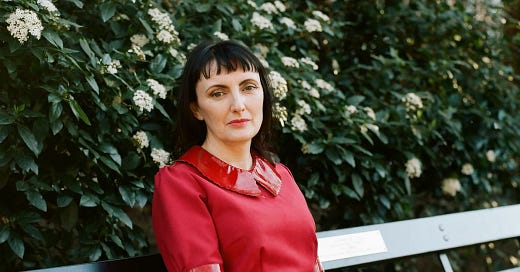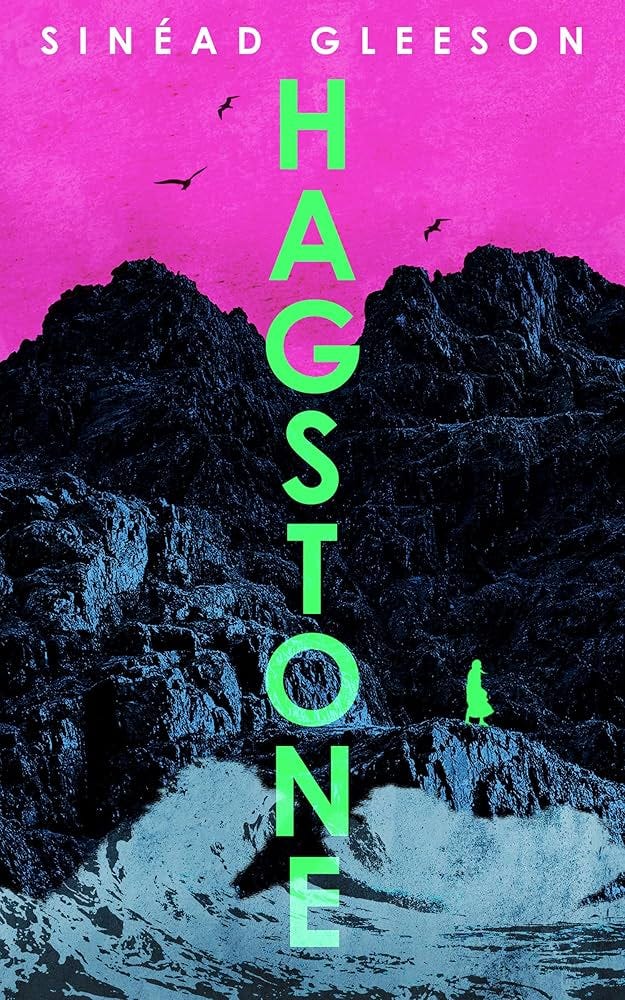Sinéad Gleeson is an author, broadcaster and editor from Dublin and an absolute legend in Irish writing.
Her debut collection of essays Constellations: Reflections from Life was published in April 2019 by Picador. It was the #1 Irish bestseller and winner of Non-Fiction Book of the Year at the 2019 An Post Irish Book Award. The essays are moving and insightful, covering health, art, gender, parenthood, bereavement, the body and her own struggles with “wonky hips” and leukaemia.
She is the editor of The Long Gaze Back: An Anthology of Irish Women Writers, The Glass Shore: Short Stories by Women Writers from the North of Ireland and The Art of Glimpse: 100 Irish Short Stories. In 2022, with Kim Gordon, she co-edited This Woman’s Work: Essays on Music, published by White Rabbit Books.
Her debut novel Hagstone was published in April 2024 to critical acclaim. It is set on a remote island off the West coast of Ireland and tells the story of a local artist called Nell and a mysterious commune of women called Inions. It’s wildly imaginative, with radiant prose that sings off the page. I couldn’t put it down.
Sinéad is steadfastly committed to books and book culture, especially when it comes to female and female identifying voices. I read a beautiful essay by Layla O Mara on Substack on writing as a bodily act. In it, she quotes Helene Cixous, saying how, in order to write the female subject, women must
“write through their bodies … must invent the … language that will wreck partitions, classes and rhetorics.”
This struck me as something Sinéad has been doing all her life. I’m delighted that she took the time to answer my questions below for Movement month.
Sinéad. Movement month on Substack is focussing on how we move our bodies. You have been through a lot of illness in your life and have written about it so powerfully, especially in your book Constellations. How have your illnesses affected your body in terms of how it moves?
I was diagnosed with mono-articular arthritis in my first week in secondary school aged 13. Until that point, I played sport, was a fast runner, walked and cycled everywhere… until a pain showed up out of nowhere. That’s the thing that’s so frightening about illness. The utter randomness of it. One day you’re fine, and the next you’re not and you realise that life will never be the same again. I had a lot of surgery in my teens - some of them fusions - which helped with pain up to a point, but severely curtailed my movement and what I could do. I knew I wouldn’t be able to run anymore, but it became clear that there were lots of other things I couldn’t do either, and that I’d always have a visible limp. But you learn to adapt to what you can and can’t do. I eventually got a hip replacement (after much dismissal by a male doctor) and got more movement back. It wasn’t the answer to everything, but it improved my life so much.
The first line of Constellations is,
The body is an afterthought.
Tell us about this please?
With any illness, there is always a ‘before’, and I realise that before my hip fell apart, I never thought about my body at all. About what an incredible thing it is; multiple, complex parts working in unity to keep us going. I definitely took it for granted. That line is a reminder to myself, and to anyone reading it, that a healthy body is a gift, and yet none of us really think about our bodies until something goes wrong…
What is it like to live with this heightened awareness of your body that comes from having experience of illness?
I learned a lot about perspective. Even when I had bad times – and my chronic pain is lifelong – I would remind myself that there’s always someone who is worse off: in more pain, or with a more complicated or terrible diagnosis. It’s a very good life lesson when you’re ill. It shuts down any tendencies towards self-pity.
How does your body and its capabilities shape your writing? Both the physical act of writing and the content of your writing…
I never set out to write a book, and especially not one that features my own experience so much. I was fearful of going back to that period (the first stretch was ages thirteen to seventeen) because it was quite bleak. But I consistently approach writing with a sense of wanting to know the answer to something. In this case, I wanted to know how much all that pain, the hospital stays, surgery etc, shaped me - and I was curious (and angry) as to why male doctors had dismissed my pain over the years. We all know our own bodies better than anyone else, even in the face of being condescended to, so I learned early on to speak up, to advocate for myself. As a patient, you have to become your own lobbyist. I’m often asked if I found writing about this - and my past leukemia – “cathartic”, but I don’t. I don’t write to feel better. I write to understand, to gain perspective, to see how I feel about certain things. My body has gone through a lot and illness has had a huge impact on me, so I’m not surprised that my writing – particularly Constellations, and even the physicality of Nell’s art in Hagstone – is so embodied.
What is your relationship to your body now? And has it changed over the years?
I used to feel very conscious about limping or posture, or the things I could or couldn’t do, and now I couldn’t care less! I was so self-conscious when I was younger and now wish I hadn’t worried about this all so much. I’m getting older and that’s sobering, to be aware of the changes and your own mortality. In the past couple of few weeks, three wonderful people I know have died who were far too young. It’s been heart-breaking, and made me so reflective. My body isn’t perfect, but it’s still going and has carried me through so much. I’m eternally grateful to it.
The central character of your brilliant debut novel Hagstone was an artist called Nell. To make her believable you had to create a unique practise and an entire body of work for her. What art do you think of when you think of womens’ bodies and movement? And is there any specific literature that has helped you to process what your body has been through?
I knew early on in the writing of Hagstone that Nell was an artist, and that she was someone who would use her body as her medium, the self as canvas, which artists like Carolee Schneemann, Yoko Ono and Ana Mendieta did. I’ve always been fascinated by durational art – art that is performed over a long period of time, sometimes only once. The ephemeral nature of it is central, and because of that it’s also something that exists outside of capitalism. People like Marina Abramović and Tehching Hsieh, and in Ireland Amanda Coogan and Aideen Barry. A lot of performance art is not the kind of work you can put on a wall, or sell, and as a result money and penury is something Nell grapples with in Hagstone. There are lots of artists in Constellations too, who taught me a lot about how to articulate illness or the body: Frida Kahlo, Jo Spence, Christen Clifford and Franko B.
Lots of writing has helped, and often it’s got nothing to do with illness or the body. Good writing, is good writing. For Constellations, I wasn’t interested in writing a memoir but started to read work by people who wrote about how their own experiences intersected with other things – art, music, science, politics, film. So writers like Leslie Jamison, Audre Lorde, Maggie Nelson and Lucy Grealy (whose memoir Autobiography of a Face is being reissued later this year) were touchstones.
The thing I didn’t expect with writing about the body is how many people would respond to it. Illness can be a lonely and isolating experience but hearing from others made me remember that patients can be a community too, and that kind of solidarity is heartening.







Thanks for the kind mention Annie. Sinead’s work is a huge inspiration for me so a real pleasure to be mentioned here. Really interesting interview 🙏🏽
Reading Constellations was quite a life-changing experience for me, to see the body expressed on the page in all its failings and wonder. At the time, I was just beginning to write my own memoir, also on the female body, but as a mother observing the impact of her daughter's disability on both our lives, whilst also navigating the changes of middle age. It was inspirational to see how such topics could be so moving, expressed with such poetry and honesty, and make for riveting unputdownable reading. I'd like to thank Sinéad for that. 💕